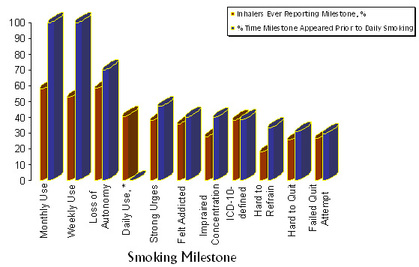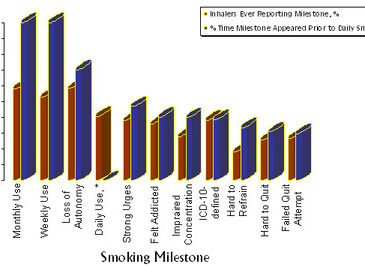During the 1970s, Russell (1971) made the claim that smoking more than 20 cigarettes a day would result in a nicotine addiction and associated withdrawal symptoms. In 2000, the Dependence and Assessment of Nicotine Dependence in Youth (DANDY) study challenged Russell’s claim and reported that withdrawal symptoms could appear from smoking as few as 5 cigarettes a day (J. DiFranza, Savageau, & Fletcher, 2002). In this week’s ASHES, we review DiFranza et al’s 2007 article examining how quickly nicotine dependence symptoms appeared among an adolescent population.
Researchers recruited 1,246 sixth graders from Massachusetts public schools and used a trained interviewer to administer three surveys per year from January 2002 to January 2006. Nearly 1000 (i.e., 970) participants completed all the surveys. Each subject used a calendar to record the following personal smoking milestones at each assessment: first puff, inhalation, start of monthly, weekly, and daily smoking, and changes in type, duration, frequency (including periods of abstinence) of smoking. Researchers also collected responses to the Hooked on Nicotine Checklist (HONC; J. R. Difranza & Wellman, 2006), and the International Statistical Classification of Diseases, 10th Revision (ICD-10; World Health Organization, 1992) criteria for tobacco dependence. Endorsement of one or more of the 10 HONC scale items indicated a loss of autonomy (1). Researchers classified participants as tobacco dependent if they experienced three or more of the 22 ICD-10 items.
The study found that both loss of autonomy and development of tobacco dependence occurred soon after first tobacco use. Focusing on the 217 participants who inhaled, researchers found that 127 had indeed lost autonomy over tobacco use and that 10% did so within two days of their first cigarette inhalation experience. Smoking an estimated minimum of seven cigarettes per month resulted in a loss of autonomy. Researchers also found that 83 participants, all of whom inhaled, developed ICD-10 defined dependence as soon as 13 days after their first inhalation, and that approximately 50% of them did so upon reaching a 46-cigerette per month smoking frequency (~1-2 cigarettes a day; J. R. DiFranza et al., 2007). Table 1 presents the percentage of participants (n=217) who endorsed HONC Scale items and how frequently these symptoms occurred before and after the onset of daily smoking.

Figure: Smoking Milestones & Their Association with Daily Smoking*. Click image to enlarge.
*adapted from Table 3, Incidence of Milestones and Their Association With Daily Smoking in DiFranza, J. R., Savageau, J. A., Fletcher, K., O’Loughlin, J., Pbert, L., Ockene, J. K., et al. (2007). Symptoms of Tobacco Dependence After Brief Intermittent Use. Archives of Pediatric & Adolescent Medicine, 7(161), 704-710.
*The milestones are listed sequentially as they occur before and after the onset of daily (e.g, loss of autonomy occurred before smoking everyday and failed quit attempts occurred after.
The study was limited by its use of interviews as its main data collection source. This methodology risks recall errors due to length of time between subsequent interviews. Furthermore, there are also personal biases that arise from and skew self-reported data. Lastly, researchers included biological tests of tobacco dependence through the collection of saliva samples (to test cotinine levels), for some but not all participants.
DiFranza et al.’s research suggests that a relatively brief time lag exists between the first tobacco use experience and the appearance of physiological dependence to tobacco and the withdrawal symptoms that emerge upon cessation. The study’s findings serve to remind adolescents that first time experimentation with various dependence producing substances is not innocuous. The days following first tobacco experience are crucial in determining whether an adolescent will experience dependence-related symptoms. The implication for substance abuse prevention programs and health administrators is that this brief time lag necessitates readily available and rapid responses to experimenting adolescents in order to interrupt the onset of withdrawal symptoms and the development of addiction.
–Ingrid R. Maurice.
Note: 1 Full autonomy is lost when the sequelae of tobacco use, either
physical or psychological, present a barrier to quitting.(J. DiFranza
et al., 2002)
References
DiFranza, J., Savageau, J., & Fletcher, K., et al. (2002). Development of symptoms of tobacco dependence in youths: 30 month follow up data from the DANDY study. Tobacco Control, 11(3), 228-235.
DiFranza, J. R., Savageau, J. A., Fletcher, K., O’Loughlin, J., Pbert, L., Ockene, J. K., et al. (2007). Symptoms of Tobacco Dependence After Brief Intermittent Use. Archives of Pediatric & Adolescent Medicine, 7(161), 704-710.
Difranza, J. R., & Wellman, R. J. (2006). Hooked on Nicotine Checklist (HONC). Retrieved March 11, 2008, 2008, from http://fmchapps.umassmed.edu/honc/TOC.htm
Russell, M. (1971). Cigarette smoking: natural history of a dependence disorder. British Journal of Medical Psychology, 44(1), 1-16.
World Health Organization. (1992). International Classification of Diseases, 10th Revision (ICD-10). Geneva, Switzerland.
What do you think? Please use the comment link below to provide feedback on this article.




